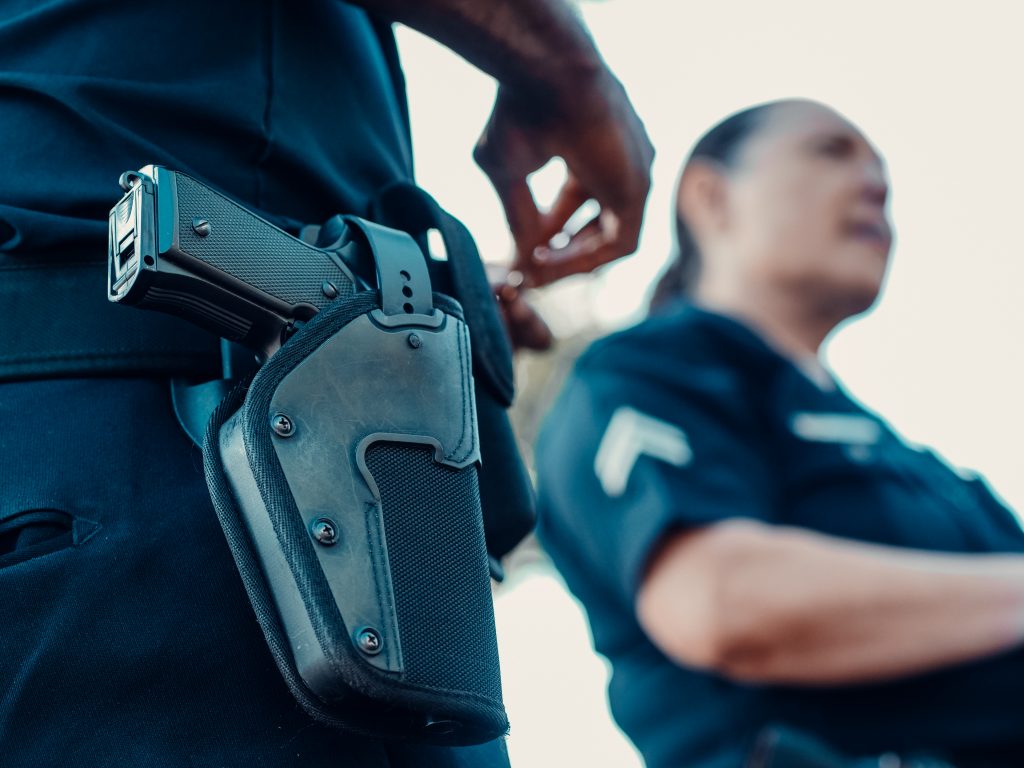My heart goes out to the people of Maine who are mourning the horrible murder of 18 people and the wounding of 13 more. I am grateful, however, that they no longer have to endure the misery of an ongoing manhunt.
As many of you know, my family was directly impacted by the recent manhunt for an escaped murderer in Pennsylvania. And I know from that experience just how awful the ordeal can be. It’s something I’ve talked a bit about in the members’ newsletter before.
However, this week I wanted to dive a little deeper into how the experience messes with your head to hopefully give some more insight into how the people of Maine may have been feeling.
Beyond the personal and emotional level, Contributing Writer Jake Fogleman examines the legal side of the story. The suspect in Maine’s mass shooting reportedly had serious mental health issues and was committed to an institution this summer. So, why did he still have a gun? And how exactly do federal and state gun laws dealing with mental health problems actually work?
Plus, the VCDL president explains how he thinks gun policy will impact the 2023 Virginia elections next month.

Analysis: The Anxiety of Waiting Out a Manhunt [Member Exclusive]
By Stephen Gutowski
On Wednesday, a man murdered 18 people and wounded 13 more in Lewistown, Maine. Then he disappeared.
Entire towns and communities were soon put on lockdown as law enforcement from every level of government descended on the area. As time moved on, we learned more about the suspect’s background. He had been hearing voices, according to family members. He threatened to shoot up the base he was stationed at as part of his non-combat service in the army reserve and was subsequently taken to a mental health facility by police. He was then committed for two weeks before being released.
He was armed with an AR variant that he bought a short time before that commitment, which he reportedly wasn’t legally allowed to keep possession of but did anyway. Those details raise far more questions about how this could have been allowed to happen that still need to be answered in the days and weeks ahead.
But, in the hours that followed the horrendous attack, the most crucial question for people in Maine was: Where did he go?
That one was followed closely by a handful of others. Is he still armed? Will he try to hurt anyone else? Will he come after my family?
Having lived through this experience a few weeks back when a murderer escaped from a Pennsylvania prison and ended up just outside my mother’s farm, I think it’s important to try and help people understand what that experience is like.
The two manhunts were similar. A murderer on the loose in a rural area armed with a rifle and a huge band of police in pursuit.
The people in Maine had it worse, though. While those of us in Pennsylvania had to deal with somebody who had a .22lr, best for plinking or squirrel hunting, those in Maine had to worry about somebody with a 308 Winchester, best for distance shooting and deer hunting. And though the Pennsylvania escapee had brutally stabbed his girlfriend to death, the Maine suspect had shot dozens of people with the exact gun he had disappeared into the wilderness with.
Plus, the guy in Maine had some form of military training and was reportedly a firearms trainer of some sort. So, there was even more reason to think he had the skills to be effective at range with his rifle.
And I can tell you the fact the Pennsylvania escapee had a rifle added a whole nother layer to the stress involved in trying to defend a home against him. When a bad guy can reach out and touch you from several hundred yards or more, that significantly complicates whatever you try to do to protect yourself and your loved ones.
It takes your already elevated stress levels and pushes them off the charts. Looking out onto a rural tree line in the dark becomes tantamount to staring into the abyss. Something evil is out there, and there’s good reason to think it intends to do the people you love harm.
The police response, as overwhelming as it might sound in a press conference, doesn’t feel all that reassuring. After all, if they knew where he was, they’d already have him in custody. The Pennsylvania convict evaded police for nearly two weeks and traveled about thirty miles from the prison he escaped from.
In Maine, police surrounded the home of one of the suspect’s family members and ordered him to come out. He wasn’t there.
Similarly, police claimed the escapee was inside a perimeter towards the end of that manhunt. But they were flying helicopters and planes well outside that area at the same time. Now, thankfully, they turned out to be correct. But, in the moment, it wasn’t very reassuring.
Add all that to the assumption that the man on the run is likely traveling at night, and you end up with an equation that will keep you up at night. All night long. Potentially for many nights in a row.
Every rustling of leaves or motion light activation or unrecognizable noise puts you on edge. You feel the overwhelming desire to check each one. It probably isn’t him, but it certainly could be.
And the truth is that one person can only stay at that heightened level of vigilance for so long. After the 10th time the motion light goes off, you might not actually go and check it. But every time you don’t take your own rifle and check to make sure the killer isn’t suddenly standing outside the door to your grandparents’ home, you feel guilty. Your stress levels increase that much more.
Your mind becomes cruel to itself. Did you just get a family member killed because you didn’t have the energy to check another false alarm at 3:45 a.m.? How will you live with it if that’s the case? How will you explain that to others, let alone yourself?
The Pennsylvania escapee only stayed in each area for a few days and was only armed for the last couple of them. So, the torment of trying to protect friends and family from him was mercifully brief. With Maine being much more rural than even Pennsylvania horse country, it seemed like that search could drag on past the dozen days ours did.
Thankfully, officials in Maine announced on Friday they had found the suspected shooter about two days into the search.
The suspect had died from what they suspected was a self-inflicted gunshot wound. He was no longer a threat. People could move on from the fear and anxiety of the manhunt to the difficult work of mourning the lives lost and trying to heal their community the best they can.
Podcast: VCDL President Gives Outlook on How Guns Impact the 2023 Virginia Elections [Member Early Access]
By Stephen Gutowski
This week, we’re looking ahead at Virginia’s off-year elections. Governor Glenn Youngkin (R.) is halfway through his first term, and now the entire state legislature is up for election.
Republicans currently have a four-vote majority in the House of Delegates, while Democrats have a two-vote majority in the Senate. That’s led to very little movement on gun policy since the Democrats lost their trifecta after passing universal background checks, a one-gun-a-month limit, a “red flag” law, local gun-free zones, and other restrictions in 2020.
The outcome of the election will either preserve the status quo or potentially lead to the repeal of at least some restrictions. That’s why we have Virginia Citizen Defense League (VCDL) president Philip Van Cleave on the show to tell us how his group sees things unfolding.
Van Cleave said VCDL is working to build enthusiasm among gun voters and get them out to the polls early. He admitted there was some concern about how motivated gun owners are in this election, in part because the threat of new gun-control laws is limited. Still, he believes gun-rights advocates should be able to pull out a win and pressure Republicans into repealing most or maybe even all of the 2020 restrictions.
Plus, Contributing Writer Jake Fogleman and I discuss the latest updates on the mentally ill mass shooter in Maine.
You can listen to the show on your favorite podcast or by clicking here. Video of the episode is available on our YouTube channel. Reload Members get access on Sunday, as always. The show goes public on Monday.

Analysis: Another Mass Shooter Slips Through the Cracks [Member Exclusive]
By Jake Fogleman
In what has tragically become all too commonplace in the United States, another mass shooting incident has been carried out by an individual who displayed numerous warning signs before attacking.
A lone attacker, armed with a rifle, killed 18 people and wounded 13 more in separate shootings in a bowling alley and a bar in Lewiston, Maine, Wednesday night. The suspect has not yet been apprehended, and more details will inevitably be released in the coming days. But local law enforcement officials have already revealed that the suspected gunman was evidently committed to a mental institution earlier this year and had a recent track record of erratic and threatening behavior leading up to the attack.
“According to law enforcement, Card recently reported mental health issues to include hearing voices and threats to shoot up the National Guard Base in Saco, ME,” a Maine Information and Analysis Center bulletin stated. “Card was also reported to have been committed to mental health facility for two weeks during summer 2023 and subsequently released.”
The Associated Press later provided more details on the suspect’s mental health commitment. The outlet said it occurred after he exhibited concerning behavior during a training exercise with his Army Reserve unit.
“A U.S. official said Card was training with the Army Reserve’s 3rd Battalion, 304th Infantry Regiment in West Point, New York, when commanders became concerned about him,” the AP reported. “State police took Card to the Keller Army Community Hospital at West Point for evaluation, according to the official, who was not authorized to publicly discuss the information and spoke to The Associated Press on condition of anonymity.”
The AP’s account, if true, indicates that the shooter slipped through a web of federal and state laws designed to keep people in his exact circumstances from obtaining firearms.
Current federal law, specifically 18 U.S.C. § 922(g)(4), makes it a felony offense for any person who has been “adjudicated as a mental defective” or who has been “committed to a mental institution” to possess or receive a firearm. A corresponding provision, 18 U.S.C. § 922(d)(4), also makes it a crime to sell a gun to someone who meets that criteria. The Department of Justice considers someone to have been committed to a mental institution if that person “has been formally committed to a mental institution by a court, board, commission, or other lawful authority” on an involuntary basis.
While not a certainty, it seems likely someone who was ordered by military personnel and escorted by state police officials to a mental hospital for two weeks might fit the bill. If so, federal law would preclude him from even possessing firearms for the rest of his life.
Beyond federal safeguards, Maine has its own state law ostensibly designed to catch and disarm people who are unstable. The state in 2019 adopted a so-called yellow flag law to allow law enforcement officials to temporarily confiscate weapons from people deemed a threat to themselves or others.
While similar in nature to the “red flag” laws on the books in 21 states and Washington D.C., Maine’s law was adopted with sweeping bipartisan support thanks to some added safeguards not included in other temporary confiscation laws. It only allows law enforcement to initiate a proceeding, rather than family members or other peers, and it specifically requires a professional medical evaluation of the individual after they are taken into protective custody. Only then is the matter brought before a judge, who can then decide whether or not to issue a temporary gun confiscation order.
Critics have charged that the law and its procedural hurdles are too restrictive to be effective, and gun-control advocates have seized on the Lewiston attack to call for a full red-flag law, among other restrictions. However, based on the preliminary information available, there’s little reason to think the current law would not apply to this suspect. If indeed the state police escorted him to a multi-week mental health commitment, especially after he had made verbal threats of carrying out a mass shooting, that would seem like a prime opportunity to initiate a yellow flag proceeding.
Law enforcement officials were already involved. A mental health evaluation took place. The only thing missing, at least based on current information, is that a formal petition was never filed by the parties charged with supervising the suspect. Had they done so, there is a good chance that a court would have ordered the disarmament of the suspect months before he ever had an opportunity to carry out his attack. Indeed, local reporting on Maine’s yellow flag law implementation has documented its use on numerous individuals exhibiting similar behavior in the last year.
Of course, many questions surrounding the incident remain. Government officials did not provide further details on the suspect’s background during a Thursday press conference. For instance, nothing has yet been revealed on how and when the suspect acquired the gun used in the shooting. And it isn’t clear whether or not his time in a mental hospital qualified as a formal involuntary commitment that would have triggered federal prohibition or whether state police at any point attempted but failed to get a yellow flag order.
But the incident appears to be yet another frustrating case of a mass shooter slipping through the cracks when, in hindsight, he should have been stopped before his rampage ever began.
That’s it for now.
I’ll talk to you all again soon.
Thanks,
Stephen Gutowski
Founder
The Reload







